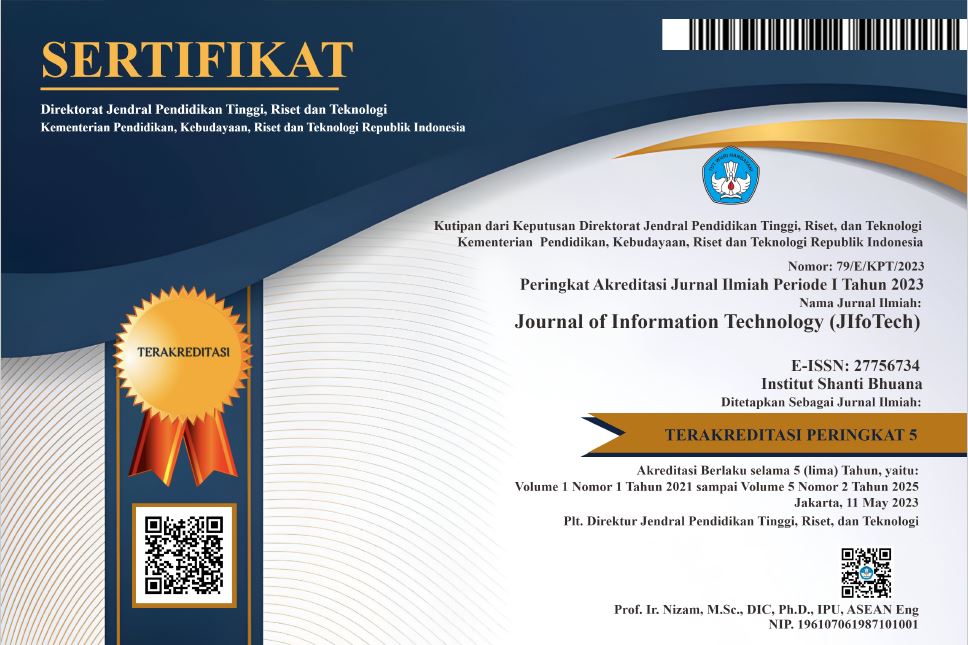Modification of Caesar Cipher Algorithm in ASCII Code to Improve Text Message Security
Abstract
Abstract— Theft of personal data is a criminal act and violates the law in the field of information technology. Therefore, the security of personal data must have a higher level of security. Personal data security can be done by one of them providing a password to the data file. To avoid password burglary, you can encrypt the password. This study uses the Caesar Cipher algorithm in the encryption process. However, some classical cryptographic algorithms that have been widely known have weaknesses that can be solved by cryptanalysis. Therefore, to avoid this, before encrypting, the caesar cipher algorithm is modified first and then converted into ASCII code. The results of the modified algorithm provide a level of message security complexity, when compared to the caesar algorithm without modification. This is shown from the results of the ciphertext that produces ciphertext in the form of combined characters, making the ciphertext more difficult to read and understand by humans, so as to increase message security and can minimize the occurrence of hacking by irresponsible parties.
References
O. Dakhi, M. Masril, R. Novalinda, and J. Ambiyar, “Analisis Sistem Kriptografi dalam Mengamankan Data Pesan Dengan Metode One Time Pad Chiper,” vol. 20, no. 1, pp. 27–36, 2020, doi: 10.24036/invotek.v20i1.647.
R. Politeknik Ganesha Medan, “Implementation of Combination Vigenere Cipher and RSA in Hybrid Cryptosystem for Text Security,” Int. J. Inf. Syst. Technol. Akreditasi, vol. 4, no. 1, pp. 471–481, 2020.
E. Setyawati, C. E. Widjayanti, R. Ramadhan Siraiz, and H. Wijoyo, “Pengujian keamanan komputer kriptografi pada surat elektronik berbasis website dengan enkripsi metode MD5,” J. Manaj. Inform. Jayakarta, vol. 1, no. 1, pp. 56–67, 2021, [Online]. Available: http://journal.stmikjayakarta.ac.id/index.php/JMIJayakarta.
A. Saraswat, C. Khatri, P. Thakral, and P. Biswas, “An Extended Hybridization of Vigenere and Caesar Cipher Techniques for Secure Communication,” 2nd Int. Conf. Intell. Comput. Commun. Converg., vol. 92, pp. 355–360, 2016, doi: 10.1016/j.procs.2016.07.390.
D. Rachmawati, S. Melvani Hardi, and R. Partogi Pasaribu, “Combination of columnar transposition cipher caesar cipher and lempel ziv welch algorithm in image security and compression,” J. Phys. Conf. Ser., vol. 1339, no. 1, 2019, doi: 10.1088/1742-6596/1339/1/012007.
M. Cao and W. Zhang, “Related-Key Differential Cryptanalysis of the Reduced-Round Block Cipher GIFT,” IEEE Access, vol. 7, pp. 175769–175778, 2019, doi: 10.1109/ACCESS.2019.2957581.
F. I. Lubis, H. F. S. Simbolon, T. P. Batubara, and R. W. Sembiring, “Combination of caesar cipher modification with transposition cipher,” Adv. Sci. Technol. Eng. Syst., vol. 2, no. 5, pp. 22–25, 2017, doi: 10.25046/aj020504.
M. M. Ali, “Cryptography : A Comparative Analysis for Modern Techniques,” vol. 8, no. 6, pp. 442–448, 2017.
T. Limbong, “Testing the Classic Caesar Cipher Cryptography using of Matlab,” no. February, 2017, doi: 10.17605/OSF.IO/PEMA5.
S. Godara, S. Kundu, and R. Kaler, “An Improved Algorithmic Implementation of Rail Fence Cipher,” Int. J. Futur. Gener. Commun. Netw., vol. 11, no. 2, pp. 23–32, 2018, doi: 10.14257/ijfgcn.2018.11.2.03.
A. Code and A. Code, “ASCII Code - The extended ASCII table,” pp. 1–7, 2013, [Online]. Available: http://www.ascii-code.com/.
A. N. Syahrudin and T. Kurniawan, “Input Dan Output Pada Bahasa,” J. Dasar Pemrograman Python STMIK, no. January, pp. 1–7, 2018.
K. R. Srinath, “Python – The Fastest Growing Programming Language,” pp. 354–357, 2017.
Google, “Colaboratory: frequently asked questions ,” 2018, [Access: 6-21-2018]. [Online]. Available:https://research.google.com/colaboratory/faq.html
Copyright (c) 2022 Mira, Hindriyanto Dwi Purnomo, Irwan Sembiring

This work is licensed under a Creative Commons Attribution 4.0 International License.






















